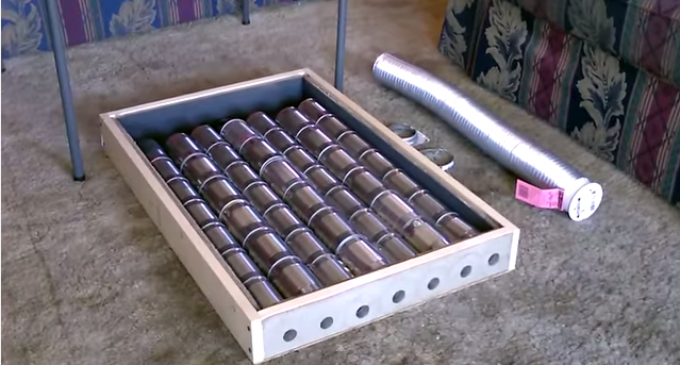
The warm summer months never last forever. Soon it’s time to look for a way to bring a little extra warmth into the home and this simple solar heater is a great project to do just that. It’s made of metal cans, steel or aluminum, and can produce a surprisingly strong and consistent airflow upwards of 140F.
Even on a heavy snow day you’re looking at somewhere around 75-85F.
Best of all, this simple project requires just a few common parts and many of them can simply be re-purposed from your regular recycling. Watch the project come together in the fully-detailed video on the NEXT PAGE:

Yes and no. As a thermotechnical engineer, solar is the illustrious unicorn. So powerful, but hard to capture the energy when needed most. This claims on a cold day it can produce a “steady flow” of 85° air. The first question is what is the inlet air temp? If it is 73, that is not enough of a delta t to increase the spacial inversion temps when it is that cold out…at least, not without a little math, and a lot of cans. I took this little experiment on just as directed and immediately find flaws- the collection device must be able to accept solar radiant energy, yet be insulated from the atmospheric loss ( cold air). Secondly, calculating airflow, btu output, heat load, and available space. To heat a 100 square foot room with medium loose construction , grade 2 insulation (all residential construction in the north east) with 5 side exposure, you would need 21,000,000 (presuming the can will collect 1/100 btu per hour with an outdoor temp of -20°f, current temp) aluminum cans, and a blower powerful enough to overcome the static pressure resistance, and build each can heat exchanger between plates of thermoglass. The blower would pull a very high amp draw, well in excess of 20,000 watts. In electrical terms, that is 3.41 btus per one watt of electricity, and would require surface exposure of 3,200×3,200 feet of space to set this up. Long story short…buy a space heater.
I liked your tec understanding of the small can solar heating device on fb. I also wondered how difficult it would be to store heat to get through the dark hours of the night.
put it inside in the room, use simple normally open normally closed thermal discs similar to those used on a furnace to operate low voltage controls. Forget the plastic piece at the end the heat will distort it…it’ll work t
Without having to rely on smarty pants fogertys input
Nice comment. What are your thoughts if air inlet comes from inside of home? And using double pane window. Maybe an insulated mass, such as 1″ concrete?
No fan, just convection.
Thoughts?
although your math is somewhat correct, thats a lot of thought put into this project on the math side of things. However, using a 12 Volt solar panel connected to a 12 Volt fan, and constructing the box with an insulated board approx. 5.8 thickness and an r rating to withstand the colder temps it could be done. also using a reflective surface behind the cans to help aid in heating the full surface of the cans would also make quite a bit of difference. And lets not forget, don’t take the air from out side, instead recirculate the air from the room-room’s being heated.
P Michael Fogarty I have seen system like this work.. Would there be away to make this one work.. Sensor connected to the motor until the hear exchange is further in temperature? Also would there not be away to have the Heated air move on it’s own?
Free heat is free heat, period. Heat rises so insulate off the ground in the winter.
Someone asked .. Solar Powerd fan.. Yes they are out there… Not real cheap…
http://www.homedepot.com/p/Active-Ventilation-5-Watt-Solar-Powered-Exhaust-Attic-Fan-RBSF-8/204202981?cm_mmc=Shopping%7cBase&gclid=CNfyt5eVl8MCFcXm7Aod4CYA_Q&gclsrc=aw.ds
This is really neat !! May have to try it, myself …
The students in my gardening club are making something like that for our hoop house in the garden…
Andres Maya?
SHARED,MI
Great idea